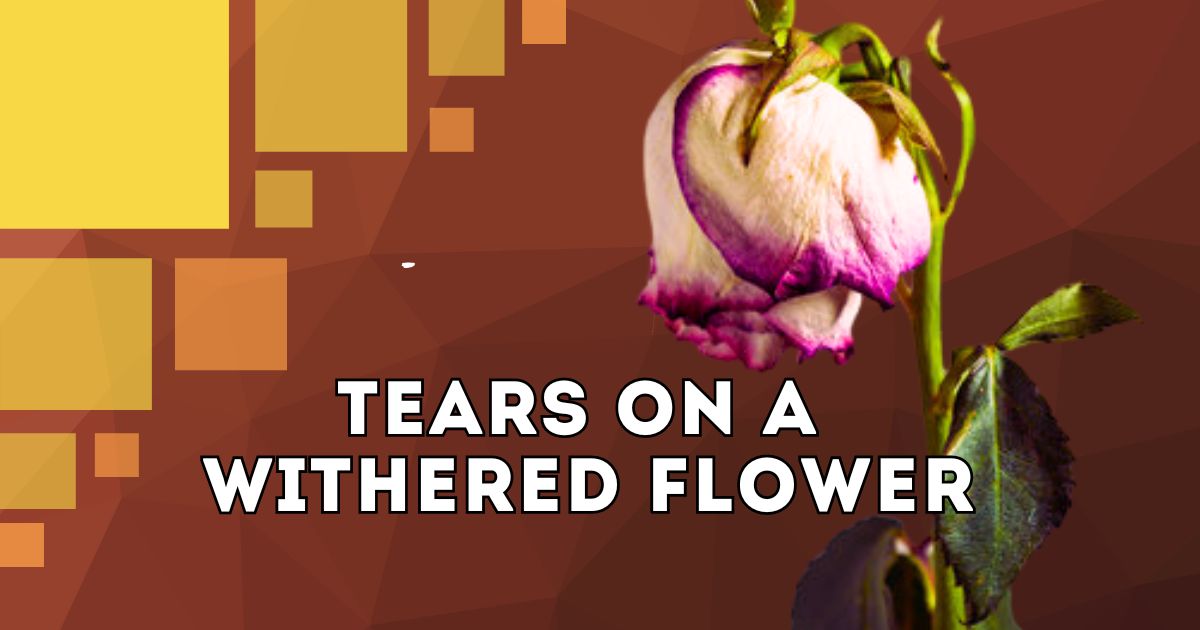In literature and poetry, metaphors hold great power. One such metaphor, “tears on a withered flower,” evokes strong emotions and complex interpretations. The imagery of tears falling on a dying or withered flower suggests a mixture of sadness, loss, and longing. This poignant symbol can be found in poems, stories, and even in visual art, representing the fragile nature of life and love. In this blog post, we will uncover the 5 deep symbolic meanings behind tears on a withered flower and explore how this metaphor resonates with universal human emotions.
What Does ‘Tears on a Withered Flower’ Symbolize? A Detailed Breakdown
The phrase “tears on a withered flower” combines two powerful images: tears, which symbolize sorrow, grief, and release, and a withered flower, which represents something that was once full of life but has faded or decayed. When these two elements come together, they create a layered symbol that can represent a variety of emotions and situations.
- Grief and Loss:
The most direct interpretation of tears on a withered flower is one of grief and loss. Just as a flower withers when it is no longer nurtured, relationships, dreams, or aspects of life can fade over time, leaving behind a sense of sadness. The tears falling onto the withered flower symbolize the human response to this loss—a recognition of what has been lost and an emotional outpouring in the face of irreversible change. - Futility of Regret:
A withered flower cannot be revived, just as certain moments in life cannot be undone. The tears on the flower represent the regret or sorrow over things that cannot be fixed, emphasizing the futility of trying to change the past. This image highlights the importance of accepting what is gone, even though it may bring pain. - Unexpressed Love or Yearning:
Tears on a withered flower can also symbolize unexpressed or unfulfilled love. The withered flower may represent a love that was once vibrant but has since faded, while the tears reflect the emotions of someone who longs for what was lost but cannot regain it. This interpretation is common in love poetry, where the image evokes the pain of separation, longing, and unreciprocated affection. - The Fragility of Life:
Flowers are often used as metaphors for the fleeting nature of life. A withered flower, in particular, suggests mortality and the inevitable passage of time. Tears falling on a withered flower remind us of the delicate balance of life, where moments of joy and beauty are temporary, and the passage of time leads to loss and decay. - Hope Amidst Despair:
Despite the image of death and loss, tears on a withered flower may also carry an element of hope. Tears often signify release and healing, while the flower, though withered, may symbolize the potential for renewal or rebirth. This interpretation suggests that even in moments of sadness, there can be a glimmer of hope, as tears have the power to cleanse and bring new beginnings.
These various symbolic interpretations of tears on a withered flower reveal the depth and complexity of this metaphor, making it a powerful tool for expressing human emotions.
Emotional and Poetic Interpretation of Tears on a Withered Flower
When viewed through a poetic lens, the metaphor of tears on a withered flower takes on even greater emotional depth. Poetry often uses imagery like this to convey feelings that are difficult to express through direct language. The tears represent a physical manifestation of emotional pain, while the withered flower serves as a visual reminder of something once cherished but now gone.
In poetry, this metaphor is often associated with themes of love, heartbreak, and mourning. A poet might use the image of a withered flower being watered by tears to represent the sorrow of losing a loved one or the pain of watching a relationship deteriorate. The tears suggest that the emotions are still alive, even though the flower (or relationship) has faded.
Many poets throughout history have turned to nature metaphors like this to express human emotions. The combination of tears and a withered flower is especially poignant because it captures both the internal experience (tears) and the external reality (the withered flower). Together, these images paint a picture of loss, sadness, and, sometimes, quiet resilience.
Why Tears on a Withered Flower Is a Powerful Metaphor for Loss and Sadness
One reason why the metaphor of tears on a withered flower is so powerful is that it captures the paradox of beauty in decay. Flowers, even when withered, can still be seen as beautiful in their fragility. Similarly, tears, though often a sign of pain, are also a symbol of vulnerability and the ability to feel deeply. When these two images are combined, they create a metaphor that is both tragic and beautiful.
- Beauty in Sorrow:
There is an inherent beauty in expressing sorrow, just as there is beauty in the delicate petals of a dying flower. The image of tears on a withered flower reminds us that emotions, no matter how painful, are a part of the human experience, and they can hold a certain beauty in their rawness. - Symbol of Endings:
The withered flower serves as a symbol of endings, whether it’s the end of a relationship, a chapter in life, or even the finality of death. Adding tears to this image deepens the sense of finality, as it suggests an emotional response to the ending—one of acceptance or grief. - Unanswered Longing:
Another layer of meaning in this metaphor is the idea of unanswered longing. The tears falling on the withered flower could represent someone who is still emotionally attached to something that has already ended. The sorrow in this metaphor is not just about loss, but about the difficulty of moving on.
The universal nature of this metaphor makes it particularly effective in literature and art. Whether in a poem, story, or painting, the image of tears on a withered flower speaks to the deep emotions we all experience at some point in life.
The Literary Significance of Tears on a Withered Flower: A Symbol of Heartbreak
In literature, flowers have long been used to symbolize a wide range of emotions, from love and joy to death and decay. The withered flower is a classic symbol of something that has passed its prime—whether it be youth, beauty, or a relationship. When combined with tears, this image becomes a poignant representation of heartbreak and emotional pain.
- Representation of Lost Love:
In romantic literature, tears on a withered flower often symbolize lost love or the end of a passionate relationship. Just as the flower has withered and lost its bloom, the love has faded, leaving behind sorrow and regret. - Metaphor for Unchangeable Fate:
The withered flower also represents the inevitability of fate. Just as no amount of tears can revive a dead flower, no amount of regret or sorrow can change certain outcomes in life. This makes the metaphor particularly tragic, as it emphasizes the futility of mourning something that cannot be restored. - Human Fragility:
The metaphor also reflects the fragility of the human heart. Just as flowers are delicate and vulnerable to the elements, so too are humans vulnerable to the pains of life—whether that be emotional loss, physical illness, or the inevitability of death.
The literary use of tears on a withered flower is a powerful reminder of the emotional toll that life’s experiences can take. It captures both the beauty and pain of the human experience, making it a lasting and effective symbol in literature.
How Tears on a Withered Flower Reflects Love and Longing
While much of the imagery of tears on a withered flower centers on themes of loss, it can also be interpreted as a metaphor for love and longing. In this interpretation, the tears represent a person’s ongoing emotional attachment to something that has withered or faded away. The withered flower may symbolize a lost lover, a dream that never came to fruition, or a hope that has long since faded.
- Enduring Love:
The tears in this metaphor could represent the enduring nature of love, even in the face of decay. The person still weeps for the withered flower because their feelings remain strong, despite the passage of time. - Unfulfilled Dreams:
In addition to love, tears on a withered flower may also symbolize unfulfilled dreams or ambitions. The flower, once full of promise, has withered away, but the tears show that the dreamer still longs for what might have been. - Poignant Memory:
The metaphor may also suggest the pain of memory. The withered flower could symbolize a beautiful moment from the past, and the tears reflect the bittersweet emotions that come from remembering something that can never be recaptured.
This blend of love, longing, and sorrow makes the metaphor of tears on a withered flower deeply relatable and emotionally resonant.
In the realm of symbolism, few flowers carry the same depth of meaning as the Black Dahlia. If you’re curious to explore more about this mysterious bloom, check out this fascinating article titled ‘5 Deep Symbolic Meanings of the Black Dahlia Flower’ here. It dives deep into the various interpretations of this enigmatic flower and how it has come to symbolize themes of mystery, strength, and even betrayal.
Conclusion: Why Tears on a Withered Flower Speaks to Universal Human Emotions
In conclusion, the metaphor of tears on a withered flower speaks to some of the most profound emotions that humans experience—grief, loss, love, and longing. Whether in poetry, literature, or art, this image captures the complexity of human emotion in a way that is both tragic and beautiful. By exploring the various symbolic interpretations of this metaphor, we gain a deeper understanding of how it reflects universal truths about life, love, and the passage of time.
Whether you see it as a symbol of loss or a metaphor for enduring love, tears on a withered flower reminds us of the fragility of life and the depth of human emotion. It is a symbol that resonates across cultures and time periods, making it one of the most powerful metaphors in literature and art.
FAQs About Tears on a Withered Flower
- What is the meaning of tears on a withered flower?
The phrase typically symbolizes grief, loss, unfulfilled longing, or the recognition of something that has passed its prime. - How is the metaphor used in poetry?
In poetry, tears on a withered flower often represents sorrow, lost love, or the fleeting nature of beauty and life. - What emotions are associated with the metaphor?
Emotions such as sadness, regret, longing, and even hope can be associated with the image of tears on a withered flower. - Why is this metaphor so powerful in literature?
The metaphor combines two potent images—tears and a withered flower—both of which are deeply symbolic and emotionally charged. - Does the metaphor have hopeful interpretations?
Yes, the presence of tears may also suggest the possibility of healing or renewal, even after something has withered or faded. - Is there a specific literary genre where this metaphor is most common?
This metaphor is frequently found in romantic and melancholic poetry, as well as in literature that deals with themes of loss and nostalgia. - What does the withered flower represent in the metaphor?
The withered flower generally symbolizes something that has faded or died, such as love, beauty, or opportunity. - How does this metaphor relate to the fragility of life?
The withered flower represents the fragile and temporary nature of life, while the tears symbolize the emotional response to this reality. - Can this metaphor be used in modern writing?
Absolutely. It remains a timeless symbol that can be adapted to modern contexts, expressing emotions that are still deeply relevant. - Where can I find examples of this metaphor in literature?
You can find examples of tears on a withered flower in classic poetry, modern literature, and even in contemporary song lyrics and visual art.




